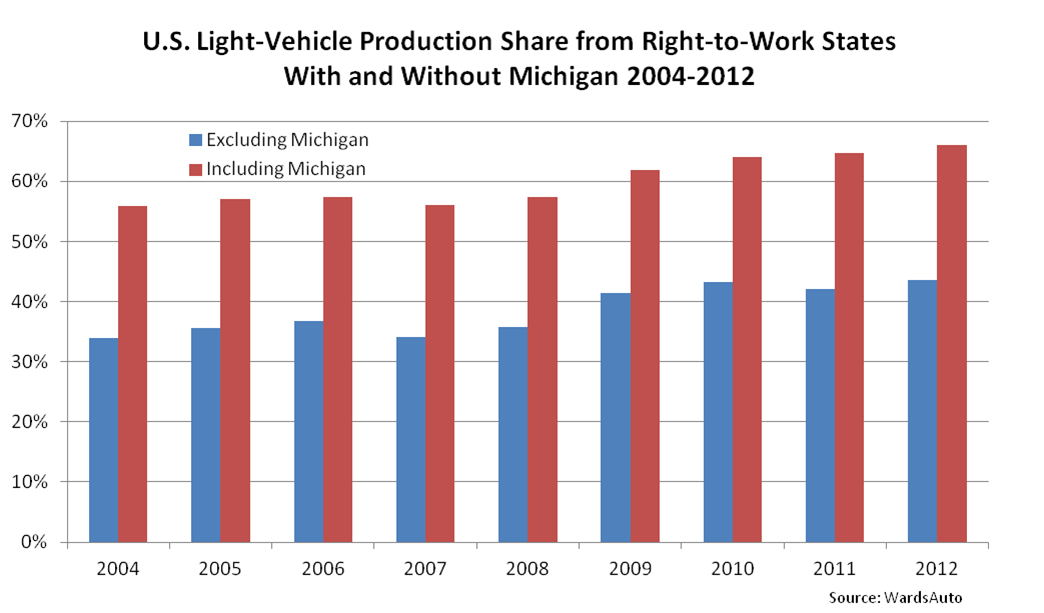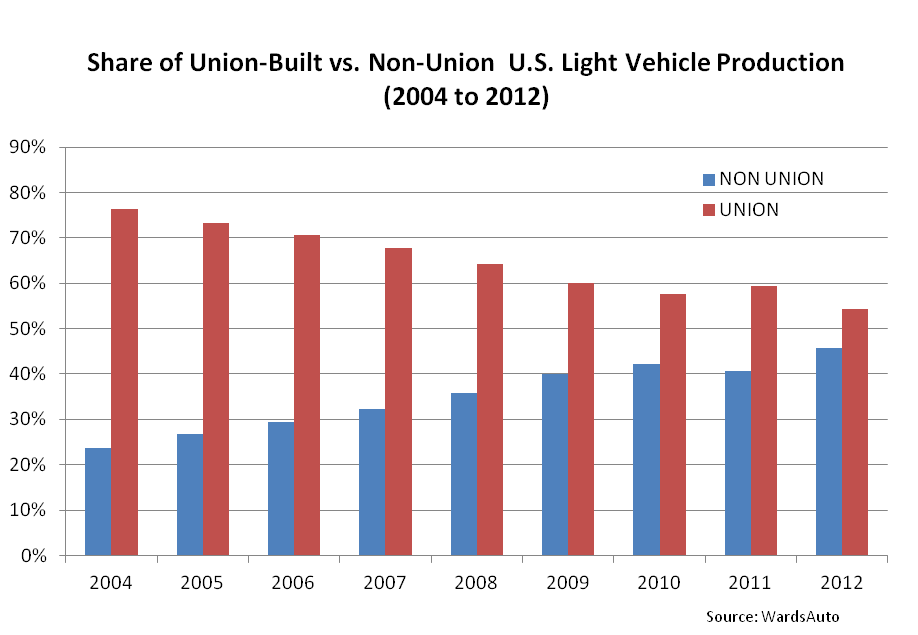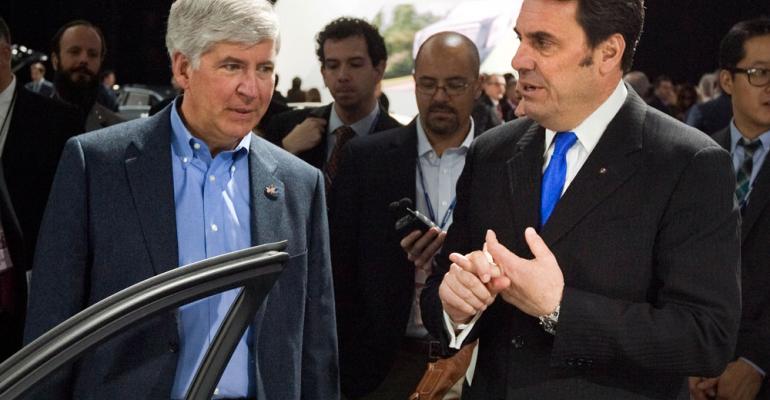Michigan’s move to a right-to-work state further swings U.S. vehicle output to regions where workers are not required to financially support a union as a condition of employment, a WardsAuto analysis shows, but experts do not see a sudden influx of auto plants into the state.
Michigan Gov. Rick Snyder, a Republican, signed the right-to-work legislation late Tuesday, shortly after the state’s legislature narrowly voted in favor of the step.
The action came despite fierce opposition from Democratic lawmakers and their unionist allies, who believe right-to-work will create a division among auto workers on the assembly line.
Predominant conservative backers of right-to-work laws argue the new statute will create jobs in a post-recessionary economy where states compete viciously for new business, and perhaps even strengthen unions by sharpening their focus on helping members.
Kristin Dziczek, a labor expert at the Center for Automotive Research in Ann Arbor, MI, says the home of the Detroit Three auto makers and the United Auto Workers union is not likely to become a reliable right-to-work state for some time.
“Just because (Snyder) signs it doesn’t mean Michigan will become right-to-work while the battle against (the law) still rages,” she tells WardsAuto.
Right-to-work opponents pledge to seek a repeal of the law in the next statewide election. One lawsuit already has been filed, charging the formation of the original right-to-work bill violated the state’s Open Meetings Act. Opponents also are seeking to recall Michigan lawmakers who voted for the legislation.
Other reasons Michigan will be stalled as a right-to-work mecca for some time includes the fact the Detroit Three labor contracts do not expire until 2015, exempting workers from the right-to-work law until then. Additionally, the Detroit-based auto makers might be reluctant to tarnish their relations with the UAW.
Moreover, Ford, General Motors and Chrysler currently operate facilities in right-to-work states with employees represented by the UAW, and there have been no mass defections from the union.
Even in Michigan, where the labor movement was founded, auto workers are not required to join the union, although they must pay the UAW administration fee meant to fund collective bargaining on their behalf.
The new right-to-work law “won’t have much of an effect for quite awhile and not much of an impact on economic development in the short term,” Dziczek says.
According to a WardsAuto analysis, much of the future assembly-plant capacity needed in North America has been assigned to Mexico. Audi, Mazda, Honda and Nissan already have committed to future production there. If right-to-work does keep auto workers’ wages in check, as the idea typically promises, Michigan could win production from Canada.
Detroit Three executives have lamented that Canada is the most expensive place in the world to build cars. The auto makers arguably could move some production into existing facilities in Michigan when their newly minted 4-year labor contract with the Canadian Auto Workers union expires in 2016.
Ford, for example, could install some cross/utility vehicle production performed at Oakville, ON, to Flat Rock, MI, while GM could add more large-car output to its Detroit-Hamtramck, MI, plant from Oshawa, ON. Chrysler could shift assembly of its minivans from Windsor, ON, as well as some large-car builds in Brampton, ON, to Sterling Heights, MI.
 Michigan joining the ranks of right-to-work states raises the share of U.S. production in those states to 66% from 44% currently, WardsAuto data shows, potentially dialing back UAW membership rolls that already are shrinking.
Michigan joining the ranks of right-to-work states raises the share of U.S. production in those states to 66% from 44% currently, WardsAuto data shows, potentially dialing back UAW membership rolls that already are shrinking.
Production in right-to-work states excluding Michigan has been growing in recent years, up 10 percentage points since 2004. As Detroit auto makers shed capacity during their recent restructurings, 26 assembly plants closed between 2004 and 2011, with all but four in union-friendly states.
In that same period, nine new vehicle factories opened with six in right-to-work states by auto makers based outside the U.S. The remaining three were union shops outside of right-to-work states.
Still, excluding Michigan from the ranks of right-to-work states, production by union-represented assembly plants between 2004 and 2011 shrank to 54% of U.S. light-vehicle output from 76%. In right-to-work states during that period, union-represented output fell to 21% from 58%.
At the same time, UAW membership dwindled from a high of 1.5 million members in 1979 to 380,719 at the end of 2011. Hiring binges by the Detroit Three led to modest back-to-back membership gains by the UAW in 2010 and 2011.
A considerable number of those hires came in under the 2-tier wage structure enacted in 2007, where new employees make half the pay of veteran workers.
 The concession by the UAW helped speed the turnaround at Ford, GM and Chrysler, and right-to-work opponents say the Michigan law will fracture the growing unity between labor and management aimed at rebuilding U.S. manufacturing power.
The concession by the UAW helped speed the turnaround at Ford, GM and Chrysler, and right-to-work opponents say the Michigan law will fracture the growing unity between labor and management aimed at rebuilding U.S. manufacturing power.
“Creating a contentious labor-management environment will not help companies to come to Michigan,” U.S. Sen. Carl Levin, a Democrat, told journalists in a conference call on Monday. Levin wants the right-to-work issue put to a vote of the state’s residents.
President Barack Obama also weighed in on the issue during a Monday visit to a Daimler engine plant in Redford, MI, warning right-to-work would slash worker wages and productivity.
“Workers were instrumental in reviving the auto industry,” Obama tells employees of Detroit Diesel, according to a White House transcript of his remarks. “Unions have helped build not just a stronger middle class, but a stronger America.
“We don't want a race to the bottom. We want a race to the top.”
Harley Shaiken, a labor expert and professor at the University of California, Berkeley, says Michigan becoming a right-to-work state could weaken the UAW’s clout in political circles as the issue turns union leaders and financial resources away from membership-building. But it also may serve as a rallying cry.
“Unions will remain powerful in an effort to overturn this and will devote full resources and a lot of energy to do it,” Shaiken says. “This won’t go away tomorrow.”
Adds Dziczek: “It could have the unintended consequence of solidifying the labor movement.”
The prospect of new jobs could ease Michigan’s transformation to a right-to-work state. Michigan lost a $1 billion Volkswagen assembly plant to Tennessee in 2008 because the German auto maker did not want organized labor in the facility, sources have told WardsAuto.
Dave Cole, an industry expert and chairman of Auto Harvest, an Ann Arbor, MI-based consortium, says a right-to-work status would complement Michigan’s vast research-and-development expertise, skilled workforce and strong supplier presence.
Auto makers are “looking for good cost structure and skilled workers,” he says. “There’s a qualified workforce here, and that’s been a problem in the South. (Right-to-work) would attract other auto makers.”
One potential problem for Michigan is the creation of a divided workforce. Even if a factory worker chose not to join or quits the union, by state law he still would be entitled to union representation at the bargaining table.
“It weakens the union overall when some people do not participate and still receive all the benefits,” says UAW Vice President Cindy Estrada. “I don’t think that’s a fair system. I think a fair system is when you have a democratic process.”
Estrada doubts the UAW’s strong presence in Michigan greatly influences where auto makers choose to construct new facilities, saying juicy tax breaks usually play the biggest role.
“There’s a number of reasons why companies don’t locate here,” she says, adding the UAW in the past has met with Snyder to boost incentives for manufacturers to locate in Michigan.
“What’s very scary about what happened, right-to-work was done without a hearing; it shoved a bill through without the Legislature being able to review the bill,” Estrada says. “What we have a problem with is a lack of transparency.”
At Michigan’s Capitol in Lansing, the “fast-tracked” right-to-work bill approved by the GOP-majority Legislature this week led to protesters’ arrests. Law enforcement reportedly used pepper spray at one point Tuesday to keep some of the thousands of demonstrators under control.
Mike Bernacchi professor of business administration-University of Detroit Mercy, warns such tension likely will escalate.
“This is tailor-made for brother vs. brother, and the hot and heavy discussions will hopefully be just that, discussions, and nothing else,” he says. “But it definitely could get ugly because it’s hard to imagine everyone will keep their wits.”
Auto makers have declined to comment on Michigan’s right-to-work controversy. It comes at a time when Ford and GM are reporting record profits and Chrysler’s turnaround is proceeding more quickly than anticipated. Profit-sharing checks for UAW members have been reinstated.
Bernacchi says Michigan’s right-to-work law puts the auto industry in a precarious position. “I’m sure the auto companies are saying, ‘Yeah, cheap labor.’ But this is chaos,” he says, adding the contentious issue likely will draw costly time and resources from auto makers, as well as the UAW.
“I’m sure there are stomachs turning.”
–with Aaron Foley, Byron Pope and Haig Stoddard





